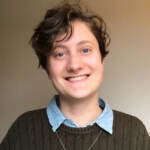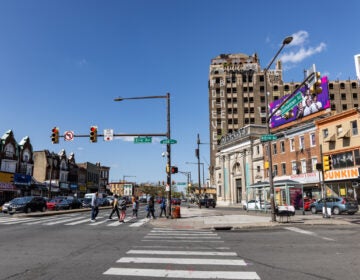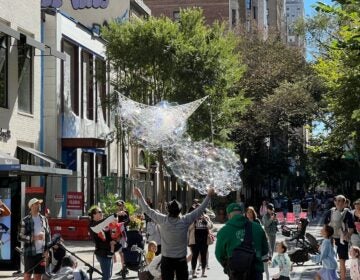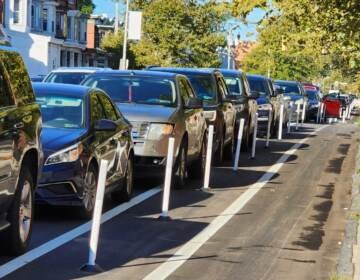After a fiery crash, a Sharswood block captain is changing the traffic rules for her community
“This is not a Nascar racing zone,” Donna Price, a North Philadelphia block captain, said. “We’re going to slow it down and have safety for our children.”
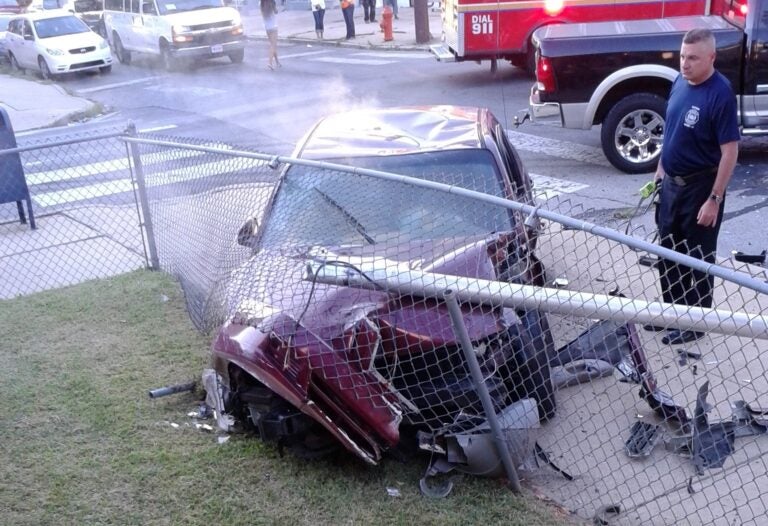
When a car crashed into Donna Price’s fence, it lit her lawn on fire. (Courtesy of Donna Price)
In the 23 years since she bought her Sharswood home, Donna Price has seen four cars crash into her property.
Speeding cars have taken down trees outside her rowhouse and uprooted the light post at 19th and Master. Time and time again, they’ve run into the fence her uncle built along the perimeter of her property. Most recently, a crash in August of 2015 damaged the chain-link structure beyond repair.
“The speeding is just horrific,” said Price, block captain of the 1900 block of Master. “Thank God for the traffic light and my fence, otherwise they would’ve landed on my porch.”
In her North Philly neighborhood, Price estimates she’s witnessed at least two crashes a year — roughly 50 in total in the two decades she’s lived there. Drivers fly down Master Street, smacking into parked cars along the way. Side streets intersecting with 19th are missing stop signs, causing visibility issues and subsequent collisions.
It became too much to bear so Price found a solution.

Working with Tenth Memorial Baptist Church, the block captain submitted an application for the city’s Slow Zone program.
The Vision Zero initiative is the city’s neighborhood-by-neighborhood approach to slowing cars and relieving dangerous traffic patterns. Funded by dollars that come to the city from drivers caught on camera running red lights, it sets up traffic calming measures in hyperlocal sections of the city, billed at $500k apiece.
Applications first opened for the program in 2018, and neighborhoods were scored based on number of crashes, community spaces (like schools or churches) and vulnerable populations living in the area. Fairhill and Kensington got the green light first, set to be unveiled in Spring 2021.
Then, the Vision Zero team announced last month, the next Slow Zones will go up at 19th and Master streets in Sharswood and in the West Passyunk section of South Philadelphia. Price is grateful.
“This is a true blessing,” she said. “It will speak volumes, that we don’t want this anymore. We don’t need this to be 95 or the Schuylkill Expressway. This is not a Nascar racing zone. We’re going to slow it down and have safety for our children.”
The final, fiery crash
The most recent crash on Price’s property, back in 2015, was also the most alarming. When a car smacked into her fence on a balmy summer day, it instantly started to burn. The grass on her front lawn caught fire, too.
Luckily Price’s neighbor is a firefighter. He rushed to the scene, cut the ignition and stopped the blaze before it got out of hand.
Still, it was the fourth time a vehicle collided with her fence. Price was disheartened.
“I was able to have someone pull the pole back up, but it’s not fixed. It’s not like it was,” said Price, who’s 60 years old. “The bottom of it is messed up. You can take your hand and push it back. It broke the foundation from the ground.”
Crashes are a constant in Price’s neighborhood. Cars often want to beat the light at 19th, so they speed down the residential neighborhood lining Master Street. An influx of multi-family housing around Temple University in recent years has meant less parking — meaning vehicles are always blocking bus lanes and curb cuts.
With a senior living center, four schools and a church in the immediate neighborhood, she fears the worst case scenario. She’s not alone — her Slow Zone application included letters of support from Girard College, St. Joe’s Prep, Gesu School and the Alliance for Progress Charter School.
“There have been several automobile accidents at the intersections where both schools are located,” reads the letter from Alliance for Progress board chair Larry Griffin. “If the problem is not addressed, the chances of a serious accident or a student being struck by a speeding vehicle is likely to happen.”
Indeed, speeding in the community is a documented problem. The Vision Zero High Injury Network — a database of the 12% of the Philly roads home to 80% of traffic deaths and injuries — includes sections of neighboring Cecil B. Moore and Girard avenues. Streets Department spokesperson Joy Huertas said two 2019 traffic studies found drivers moving through the area at faster speeds than in most parts of the city. Across Philadelphia, neighborhoods like Sharswood with more Black and brown residents than white residents comprise 49% of the city’s most crash-prone streets, according to a 2018 Bicycle Coalition of Greater Philadelphia analysis, despite containing less of the city’s total street mileage.
Huertas said the city will continue to study traffic patterns to determine a full plan to reduce crashes and improve safety in Sharswood.
“We… will reassess the area to see what controls can be put into place to deter what appears to be reckless driving,” Huertas said.
In the meantime, people like Lynette Shaki are establishing their own traffic regulations. Shakti lives on the 1800 block of Master Street. Her 17-year-old son just got his driver’s permit, and she’s teaching him to drive — with a few restrictions. He’s not allowed to drive down Ingersoll or Seybert streets, since there aren’t stop signs where they intersect with 19th.
“I point out specific blocks to take, and I have him skip certain blocks to make sure he can come home safe,” said Shaki, a school teacher. “Sometimes people are parked very far up on the corner. You have to kind of make a judgment call, not being able to see. A new driver would have a lot of trouble driving around here.”
A first step to stop reckless driving
The Slow Zone program is now in the very beginning stages: The intense community engagement process won’t start until the weather warms up, so gatherings can be held outside.
Then, like the ones that came before it, the Sharswood Slow Zone will take years to build.
“We kind of have to roll with it and see where we’re at in the spring,” said Kelley Yemen, director of complete streets at the city’s Office of Transportation, Infrastructure, and Sustainability.
What will the community ask for? Price said she’s interested in speed cushions lining 19th and Master streets, and better enforcement of cars parked in bus loading zones. Shaki wants more stop signs, and signs posted to ask drivers to slow down.
“My biggest concern is safety — the safety of the children, the safety of the seniors who don’t walk as fast,” Price said. “Nothing gets addressed until someone gets hurt. I don’t want injuries in order to get progress.”

Subscribe to PlanPhilly
WHYY is your source for fact-based, in-depth journalism and information. As a nonprofit organization, we rely on financial support from readers like you. Please give today.



